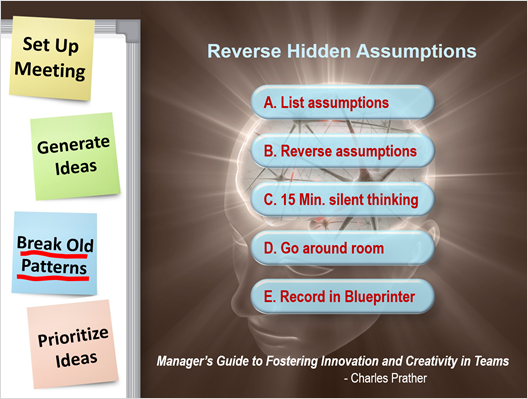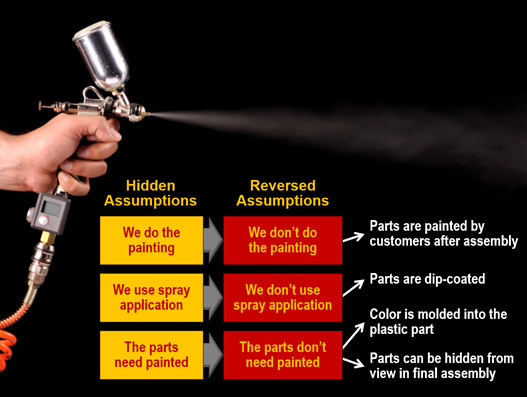Most teams overlook this powerful way to generate more novel ideas.
The third Blueprinting Technical Brainstorming step is to break old thinking patterns. In the last step, Generate Ideas (last article) you let everyone empty their brains of all the ideas they had… but that’s often not enough. As Einstein said, “No problem can be solved using the same type of thinking that created it.”
We all think in certain patterns that are useful, but prevent us from thinking in novel, truly innovative ways. To get our neurons firing in new ways, a skilled facilitator can use trigger methods to break these patterns. For more on these, see Charlie Prather’s book, Manager’s Guide to Fostering Innovation and Creativity in Teams.
Probably the most helpful trigger method is also the one you can most easily do yourself: “Reverse Hidden Assumptions.” First, you list all the assumptions the group can think of. Then you reverse them, give everyone 15 minutes of silent thinking time, and go around the room, recording the new ideas in Blueprinter as you did earlier.

Here’s an example: Imagine if a business was currently spray-painting plastic parts, and this was adding a lot of cost. The problem statement your group had been working on is, “Minimize the cost of painting plastic parts.” Your hidden assumptions might include…
- We do the painting
- We use spray application
- The parts need painted.
These don’t have to be bad assumptions. Just try to “surface” assumptions that often go unspoken. You’d then reverse these assumptions:
- We don’t do the painting
- We don’t use spray application
- The parts don’t need painted.

Now have your group spend 15 minutes thinking about this “alternate world” where the reversed assumptions are true. When your brainstorm group looks at this list, it puts them in a different mental space. There might not be a direct connection between the reversed assumption and their new idea, but the reversed assumption just caused “different” thinking. With this list, the group might come up with ideas such as…
- Parts are painted by customers after assembly
- Parts are dip-coated
- Color is molded into the plastic part
- Parts can be hidden from view in the final assembly
For more on this topic, see e-Learning Module 29: Technical Brainstorming at www.blueprintingcenter.com > e-Learning.
Keywords: Blueprinting Step 6: Technical Brainstorming, solution brainstorming, solution ideation, technology development, product development, break old thinking patterns, trigger more ideas, reverse hidden assumptions
